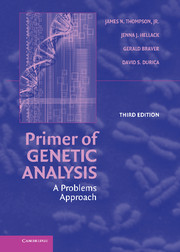Book contents
- Frontmatter
- Contents
- Preface
- Note on Genetic Symbols
- 1 Overview of Genetic Organization and Scale
- 2 Mitosis and Meiosis
- 3 Nucleic Acids: DNA and RNA
- 4 Basic Mendelian Genetics
- 5 Probability and Chi-Square
- 6 Sex-Linkage and Gene Interactions
- 7 Pedigree Analysis
- 8 Overview of Basic Statistical Testing
- 9 Quantitative Inheritance
- 10 Overview of Genetic Mapping
- 11 Assessing Chromosome Linkage Relationships
- 12 Linkage and Mapping in Diploids
- 13 Mapping in Bacteria and Viruses
- 14 Overview of Types of Genetic Change
- 15 Gene Mutation
- 16 Changes in Chromosome Number and Structure
- 17 Protein Synthesis and the Genetic Code
- 18 Gene Regulation and Development
- 19 Overview of Molecular Biology Techniques
- 20 DNA Mapping and Human Genome Analysis
- 21 Basic Population Genetics
- 22 Selection and Evolution
- 23 Practice Tests
- 24 Answers to Practice Tests and Crossword Puzzles
- 25 Landmarks in the History of Genetics
- Glossary
- Reference Tables
18 - Gene Regulation and Development
Published online by Cambridge University Press: 05 June 2012
- Frontmatter
- Contents
- Preface
- Note on Genetic Symbols
- 1 Overview of Genetic Organization and Scale
- 2 Mitosis and Meiosis
- 3 Nucleic Acids: DNA and RNA
- 4 Basic Mendelian Genetics
- 5 Probability and Chi-Square
- 6 Sex-Linkage and Gene Interactions
- 7 Pedigree Analysis
- 8 Overview of Basic Statistical Testing
- 9 Quantitative Inheritance
- 10 Overview of Genetic Mapping
- 11 Assessing Chromosome Linkage Relationships
- 12 Linkage and Mapping in Diploids
- 13 Mapping in Bacteria and Viruses
- 14 Overview of Types of Genetic Change
- 15 Gene Mutation
- 16 Changes in Chromosome Number and Structure
- 17 Protein Synthesis and the Genetic Code
- 18 Gene Regulation and Development
- 19 Overview of Molecular Biology Techniques
- 20 DNA Mapping and Human Genome Analysis
- 21 Basic Population Genetics
- 22 Selection and Evolution
- 23 Practice Tests
- 24 Answers to Practice Tests and Crossword Puzzles
- 25 Landmarks in the History of Genetics
- Glossary
- Reference Tables
Summary
STUDY HINTS
The problem of how genes are turned on and off at the proper time is a fascinating one. Geneticists still have a lot to learn in this area. Particularly in eukaryotic cells, the interaction between the nucleus and cytoplasm and the coordinated activation of functionally related genes at different times or in different tissues make development a complicated process, even in the simplest organisms. The operon model in prokaryotes is probably not directly analogous to the control systems of higher organisms, but it is an excellent place to begin getting the feel of the logic of regulatory systems.
There are two main types of operons: inducible and repressible. Inducible operons are normally turned off, since a repressor protein is bound at the operator site (O) and thus blocks RNA polymerase, which binds at the promoter site (P). Active transcription is blocked. Inducible operons can be activated by some substrate (the inducer) that binds with, and deforms, the repressor protein. Typically the inducer is some substance that is acted upon by the enzymes coded in the operon, so that the operon is turned on only when its products are needed by the cell. The repressor gene (i) may be quite distant from the operon, but the promoter and operator must be adjacent to the structural genes (SG1, SG2, etc.) that they control. The key is that the represser gene's diffusible product is synthesized in an active form.
- Type
- Chapter
- Information
- Primer of Genetic AnalysisA Problems Approach, pp. 177 - 185Publisher: Cambridge University PressPrint publication year: 2007



